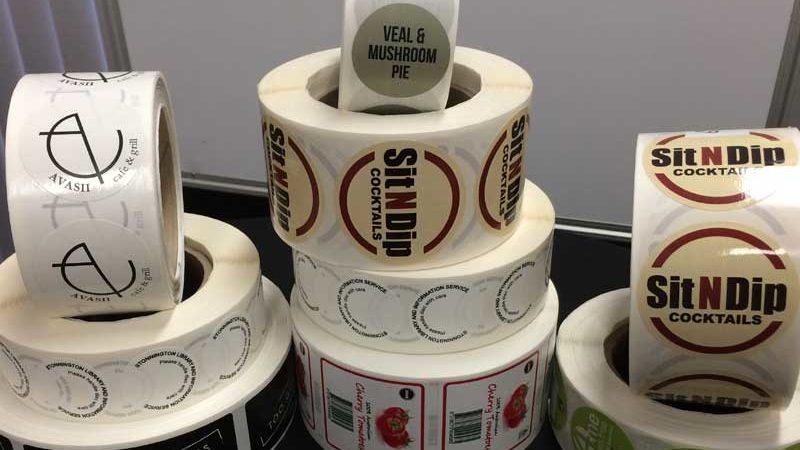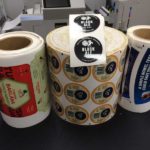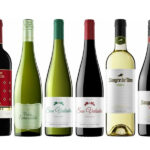Waterproof vs Water resistant Labels
The label and packaging industry is vast and varied, and within its confines, one can find an array of technicalities that often go unnoticed by the average consumer. Among the nuances is the differentiation between water-resistant and water repellent labels. These terms, though seemingly synonymous, have distinct differences in production and functionality that industry professionals should be aware of.
Among the many external challenges a label might encounter once affixed to a product’s packaging, moisture stands out as a primary adversary. The resilience of these labels can be categorized into two main types: water-resistant and waterproof. Drawing a parallel to wristwatches, water-resistant labels can endure the sporadic drizzles and occasional splashes, much like watches worn under a light rain. On the other hand, waterproof labels, akin to diving watches, remain unfazed even when submerged or exposed to prolonged water contact.
The Logic Behind Waterproof and Water-Resistant Labels
Thus, it’s evident that shampoo bottle labels need to be waterproof. Given that they reside in high-humidity environments like bathrooms and frequently encounter direct water streams, they must resist the onslaught of moisture. Conversely, the label on a bottle of eau de toilette only requires water-resistant properties. While it may be exposed to occasional droplets of condensation, it’s unlikely to be submerged in water.
As for tea and coffee packages, their labels often go without any moisture protection. Typically stored in dry conditions at room temperature, there’s minimal risk of them encountering adverse moisture levels. But again, depending on the brand’s positioning and the packaging’s intended purpose – be it for luxury blends or gifts – there might be variations in label quality. Waterproof and water-resistant labels, in this context, aren’t just functional assets; they’re markers of brand quality and trust.
Achieving Label Perfection
How can one preserve the consumer qualities of a label, ensuring that its imagery doesn’t smudge and the material doesn’t peel off?
First and foremost, it’s crucial to choose the right material. Self-adhesive paper typically won’t suffice, except for a few rare specialty types, which often come at a higher price than polymer film.
Polymer film, by its very nature, resists moisture quite well. However, to safeguard the printed image, additional protection is essential. Applying a coat of varnish or using a laminate overlay can serve as effective barriers. These additional layers not only shield the label from moisture but also protect against scratches, abrasions, and general wear and tear, prolonging the label’s life and preserving its aesthetic appeal. Investing in such protective measures ensures that the label remains intact and legible, reflecting positively on the brand’s image and enhancing the overall user experience.
Water-resistant labels
Water-resistant means that an object has the ability to ward off water to a certain extent but not entirely. You’ll find water-resistant watches, mobile phones, and the like, where the casing and display are either made from water-resistant material or treated with a water-resistant agent. However, there’s a limit to how much water it can fend off, and over time, if subjected to continuous moisture, these objects may let water in. This is why swimmers and divers would avoid relying solely on items labeled merely as water-resistant. They might be fine under a light drizzle but will eventually give in under submerged conditions or heavy rainfall.
Water-resistant labels, similarly, are designed to repel water up to a point. They might endure occasional splashes or damp environments, but they aren’t built to remain submerged in water for prolonged periods. These labels are often treated with a special coating or made of materials that prevent water from seeping in immediately. The advantage of such labels is that they maintain their legibility and adhesive qualities in moist conditions, which is essential for products that might face such environments. However, for products that might be entirely submerged, waterproof labels printing would be the better choice.
In essence, water-resistant materials, be it for labels or any other products, offer a degree of protection from water but have their limitations. Knowing these boundaries ensures that the products are used in conditions they’re designed for, thus maximizing their lifespan and functionality.
Waterproof labels
To say something is “waterproof” when discussing labels means that the label has been designed to resist and repel water completely. In today’s market, there are not only waterproof clothing, watches, and phones, but also waterproof labels that can withstand various environmental challenges.
Waterproof labels have become an indispensable tool for products that may encounter moisture, be it from rain, spills, or humidity. This ensures that the product’s information remains legible and intact, regardless of the circumstances. If you’re shipping goods by sea or storing items in humid conditions, a waterproof label ensures that crucial data doesn’t get washed away.
But one critical thing to remember is that waterproof doesn’t always mean “invincible.” While they are resistant to water, factors like UV rays, extreme temperatures, or prolonged exposure can challenge their durability. Yet, when compared to regular labels, they offer a heightened degree of protection.
Constructed using specialized materials and coatings, waterproof labels often feel sturdier to the touch. Their adhesive is typically stronger as well, preventing the label from peeling off due to water interference. But while they’re impermeable to water, they are still breathable to some extent. This prevents the trapped moisture or air bubbles from causing the label to detach.
However, it’s essential to apply these labels correctly. If the surface isn’t clean and dry, even the most robust waterproof label might not adhere properly. Always ensure the surface is prepared before applying to get the maximum benefit from these water-resistant marvels.
Quality and Cost
Waterproof and water-resistant labels differ notably in their production costs. Waterproof labels, engineered to withstand total immersion, demand premium materials and advanced technologies to maintain their aesthetics and adherence, even when submerged. This intricate production process, combined with superior materials, often results in a heftier price tag. Conversely, water-resistant labels, designed to repel moisture but not to endure prolonged submersion, often utilize less expensive materials and simpler production techniques. Their purpose is to combat occasional splashes, not prolonged exposure. Consequently, the investment in producing waterproof labels is generally higher, reflecting their superior resilience and longevity compared to water-resistant labels.
Choosing between these types of labels can be about non-functional choices, but also a reflection of the longevity of the product and the brand’s commitment to quality. It demonstrates how every detail, down to the label, has been carefully considered to stand up to real-world testing. A consumer noticing a faded or damaged label may immediately question the quality of the product. Therefore, choosing a waterproof or water-resistant label is not only practical, but also a means of instilling confidence in the consumer and reinforcing the brand’s promise of high quality.


